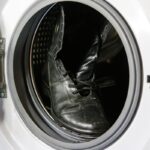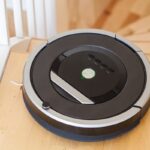Most people buy Roombas to make vacuuming their floors easier. If you have just invested in one of these effort-saving small appliances, how long do they take to clean?
A Roomba takes approximately one or two hours to clean, but this depends on the size of your room and the stability of your Wi-Fi connection. Generally, it will take this amount of time if your room is around 2,000 square feet (185.8 sq m).
In this article, I’ll explore why a Roomba takes this amount of time to clean. I’ll also answer various common questions about how Roombas work and how they learn about your home’s floor plan so they can clean them thoroughly. Let’s dive right in!

How Long Does a Roomba Take To Clean?
It takes a Roomba between one and two hours to clean your home’s floors. However, this depends on various factors, including:
- Your living space’s size and shape. A large surface area will take the Roomba longer to clean. Also, if your room has an irregular shape, it will take the Roomba longer.
- Your Wi-Fi connection. Without a stable Wi-Fi connection, your Roomba won’t work as effectively as it should and might keep losing its connection. Features like customized cleaning plans also won’t be available if you don’t have a stable Wi-Fi connection.
- Obstacles in the cleaning path. It will take longer to clean if your Roomba has to move around obstacles on the floor, such as furniture or other items. However, it can clean over obstacles that are shorter than 0.625 inches (1.5875 cm) in height. To speed up the cleaning time, consider removing small obstacles beforehand.
How Long Does a Roomba Mapping Run Take?
A Roomba mapping run takes three to five sessions. During this time, the device learns about your home’s layout using a technology called Imprint Smart Maps. This enables it to learn how to navigate your home efficiently.
During the mapping run, your Roomba moves around your entire home without using its vacuuming ability. This allows it to collect information about your floors and determine where the corners and objects are in its cleaning path, so it knows to avoid them in the future.
However, if you want your Roomba to clean while it maps your home, this could take up to five sessions to achieve before it will have mapped your home thoroughly, as Digital Trends reports. You can help your Roomba better map your home by making it easy to navigate. Here’s how to do it:
- Remove anything that will get in the way of your Roomba, such as shoes and children’s toys.
- Open doors between rooms so that your Roomba can easily access every area of your home.
Does Roomba Know When Room Is Clean?
A Roomba knows when a room is clean because it has sensors on board. While these sensors help it to engage in house mapping so that it knows how to navigate your living space, they also have other functions, such as starting or stopping the Roomba.
A Roomba’s sensors help it to detect dirt and how dirty your floors are. Specifically, it has a piezoelectric sensor that detects dirt when bits of dust and debris strike it. When this occurs, the Roomba receives electrical impulses that make it continue cleaning your home.
When there’s no more dirt reaching the sensor, the Roomba knows that it should stop cleaning because its job is done. It then returns to the charging station.
Can I Pick Up My Roomba and Move It to Another Room?
You shouldn’t pick up your Roomba and move it to another room because this interferes with its cleaning cycle. Doing this makes it difficult for the Roomba to locate the charging station. You should let it complete its cleaning cycle, as iRobot reports.
If you simply can’t resist moving your Roomba to another room, such as if you want to do a quick spot clean, make sure you also move its docking station. The Roomba needs to start cleaning from the docking station, or it won’t be able to locate its home after its cleaning session.
Should I Run My Roomba Everyday?
You should run your Roomba every day if your home experiences heavy traffic and you have pets and kids. However, this decision is entirely up to you. Regularly using your Roomba helps to keep its lithium batteries in good condition and prevents them from deteriorating.
Alternatively, you can use it once a week if your flooring only requires a weekly cleaning.
Using a Roomba daily is simple because it self-adjusts to different floor types. So, whether you have a carpet or tiled floor, you won’t have to prepare your Roomba for efficient cleaning. It’s similar to a Dyson that self-adjusts, and it’s completely convenient to use your Roomba daily because it only requires two hours to charge and will be ready for use whenever you want it to work.
How Long To Cool Down
Your Roomba doesn’t need time to cool down like a traditional vacuum cleaner that can feel hot after an intensive cleaning session. Instead of letting it cool down, you should continue recharging it after use. Make sure you keep your Roomba plugged in, as it should remain charging in its home base.
If you will not be going to use your Roomba for a few weeks, you should put it in ship mode (which you can do by opening the cover of your Roomba and putting the power switch in the “O” or OFF position). Store your Roomba in a dry, cool area in the home so that it’s not exposed to high temperatures.
Final Thoughts
If you want to start using a Roomba to clean your home, it helps to know how long it will take to get the job done. Generally, a Roomba takes about an hour or two to clean your home, although this depends on factors such as the floor layout and the shape of your living space.





